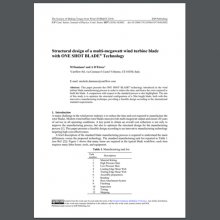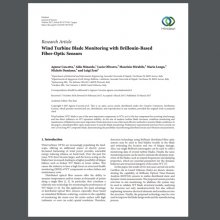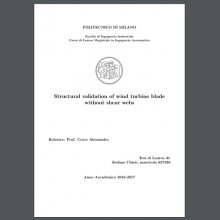Papers
Design Solutions in One Shot Blade ®
One Shot Blade ® Technology is a manufacturing process that allows to produce a wind blade with a closed mould in one single infusion step.
This process enables the drastically reduction of work and re-work time. One of the main advantages of producing with this technology is the high precision (repeatibility) of the final product.
Furthermore, this technology has been adopted for more than 2000 blades of small wind turbines (from 20kW up to 200kW).

Manufacturing and Design Features of One Shot Blade ® Technology
An assessment on the One Shot Blade® technology focused on the following topics:
- manufacturing process (cycle time, costs …)
- structural topology
- product and process reliability
The opportunity to adopt the fiber volume fraction as a variable in the structural design loop is investigated in detail. The structural assessment of a typical cross section of a 20m wind blade, designed to be manufactured with One Shot Blade® technology, has been performed according to strength, fiber failure, inter-fiber failure and fatigue verification criteria as established by GL2010 guidelines.

Structural design of a multi-megawatt wind turbine blade with ONE SHOT BLADE ® Technology
This paper presents the ONE SHOT BLADE® technology introduced in the wind turbine blade manufacturing process in order to reduce the time, and hence the costs required to build the blade.
A comparison with respect to the standard process is also highlighted.
The aim of this study is to optimize the structural configuration of a 50m length blade, built with this innovative manufacturing technique, providing a feasible design according to the international standard requirements.

Wind turbine blade monitoring with Brillouin-Based Fiber-Optic Sensors
Wind turbine (WT) blade is one of the most important components in WTs, as it is the key component for receiving wind energy and has direct influence on WT operation stability. As the size of modern turbine blade increases, condition monitoring and maintenance of blades become more important.
Strain detection is one of the most effective methods to monitor blade conditions. In this paper, a distributed fiber-optic strain sensor is used for blade monitoring.
Preliminary experimental tests have been carried out over a 14 m long WT composite blade, demonstrating the possibility of performing distributed strain and vibration measurements.

Structural validation of wind turbine blade without shear webs
In the context of the multidisciplinary design of modern wind turbines, this work focuses on the structural optimization of a horizontal axis rotor blade following an innovative one-shot technology. In this strategy, a classical sectional topology based on the common spar-box arrangement is modified so that the two main shear webs are removed from the design.
This allows to manufacture each blade in a single molding phase, whereas the current industrial practice requires to manufacture the two halves of the blade independently, since they are subsequently joined together through the shear webs.
